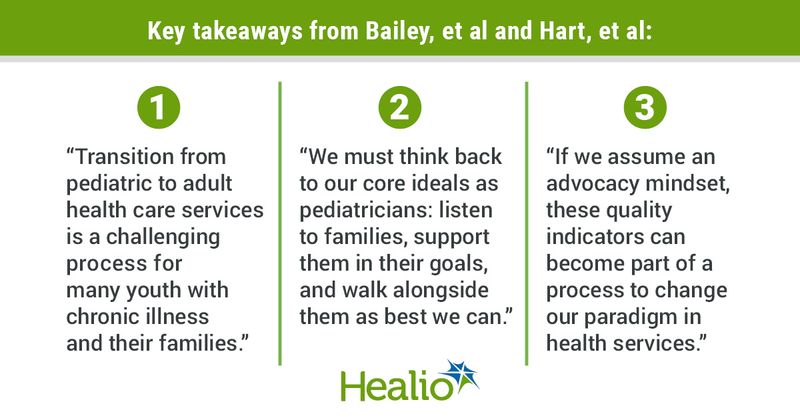Review finds gaps in quality indicators for transition from youth to adult care
A systematic review identified gaps in quality indicators for transitioning chronically ill patients from youth to adult care, researchers reported in Pediatrics.
Among the gaps, the researchers found that patients and caregivers were rarely included in the development of quality indicators, which can track the quality of a patient’s care. Moreover, none of the indicators focused on equity of care, they said.

According to the researchers, as many as 15% of youths living in North America have a chronic condition and will transition to adult care, generally between the ages of 16 and 19 years old — “a challenging process for many youth with chronic illness and their families.”
“Transition to adult care is associated with patient-safety risks across chronic conditions, including diabetes, inflammatory bowel disease, organ transplantation, congenital heart disease, and sickle cell disease. Several studies have reported deterioration in patient health status, disease complications, psychosocial distress, reduced medication, and treatment adherence, and increased acute-care usage after transition to adult care,” the researchers wrote.
“Youth simultaneously undergo developmental changes, such as gaining independence, new social relationships, and achieving educational or vocational milestones,” they wrote. “The needs of youth during this critical period in their development are often inadequately met, risking dissatisfaction and disengagement from care. Despite these challenges, there is no consistent and universal approach to evaluate and track performance and outcomes during transition for youths with chronic illness.”
The researchers conducted a systematic review of articles published in the databases Medline, Embase and the Cumulative Index to Nursing and Allied Health Literature regarding transitioning from youth to adult care.
They included 321 articles in their full-text review. The articles identified 169 quality indicators for transition — 56% were illness specific, 43% were at the patient level of care, 44% were related to transition processes and 51% were patient centered, whereas none of the indicators focused on equity.
“To date, existing research has focused on quality indicators related to satisfaction, transition education and planning, continuity of care, satisfaction, and self-management/self-efficacy,” the researchers wrote. “Most quality indicators were patient-centered measures.”
They did, however, notice gaps in the quality indicators when it came to caregivers.
“Although more than 50% of quality indicators were patient and caregiver level, these stakeholders were rarely included in the development process,” they wrote. “Furthermore, there were no equity-related metrics and many indicators had unclear measurement characteristics.”
In an accompanying editorial, Laura C. Hart, MD, MPH, of the Ohio State University College of Medicine, and Michael E. Msall, MD, of the University of Chicago Prizker School of Medicine, said one group of patients caught their attention: youth with intellectual and developmental disabilities (IDDs).
“Without specific measures and evidence-based management pathways, providers caring for youth with IDD must negotiate several fragmented systems including health, education, vocational training, and community-based independent or supported living without clear targets or goals,” they wrote. “This can feel overwhelming, as we seek to provide the best care that we can without a clear definition of what that even is.”
Hart and Msall said that if providers assumed “an advocacy mindset,” such quality indicators could become part of a way “to change our paradigm in health services from expensive crisis management pathways to interventions of prevention and wellness, and bring that goal of a thriving adulthood for youth with IDD closer to reality.”
“We must think back to our core ideals as pediatricians: listen to families, support them in their goals, and walk alongside them as best we can,” they continued.
Reference:
Bailey K, et al. Pediatrics. 2022;doi:10.1542/peds.2021-055033.
Hart L, et al. Pediatrics. 2022;doi: 10.1542/peds.2022-057310.
